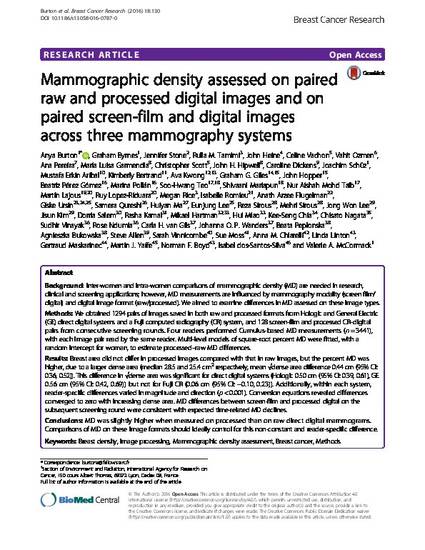
Background: Inter-women and intra-women comparisons of mammographic density (MD) are needed in research, clinical and screening applications; however, MD measurements are influenced by mammography modality (screen film/ digital) and digital image format (raw/processed). We aimed to examine differences in MD assessed on these image types.
Methods: We obtained 1294 pairs of images saved in both raw and processed formats from Hologic and General Electric (GE) direct digital systems and a Fuji computed radiography (CR) system, and 128 screen-film and processed CR-digital pairs from consecutive screening rounds. Four readers performed Cumulus-based MD measurements (n = 3441), with each image pair read by the same reader. Multi-level models of square-root percent MD were fitted, with a random intercept for woman, to estimate processed–raw MD differences.
Results: Breast area did not differ in processed images compared with that in raw images, but the percent MD was higher, due to a larger dense area (median 28.5 and 25.4 cm2 respectively, mean √dense area difference 0.44 cm (95% CI: 0.36, 0.52)). This difference in √dense area was significant for direct digital systems (Hologic 0.50 cm (95% CI: 0.39, 0.61), GE 0.56 cm (95% CI: 0.42, 0.69)) but not for Fuji CR (0.06 cm (95% CI: −0.10, 0.23)). Additionally, within each system, reader-specific differences varied in magnitude and direction (p < 0.001). Conversion equations revealed differences converged to zero with increasing dense area. MD differences between screen-film and processed digital on the subsequent screening round were consistent with expected time-related MD declines.
Conclusions: MD was slightly higher when measured on processed than on raw direct digital mammograms. Comparisons of MD on these image formats should ideally control for this non-constant and reader-specific difference.
Available at: http://works.bepress.com/m-chiarelli/8/